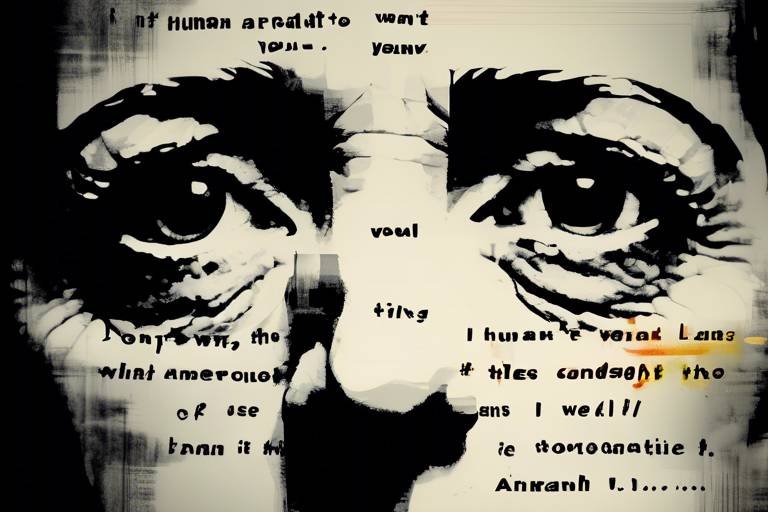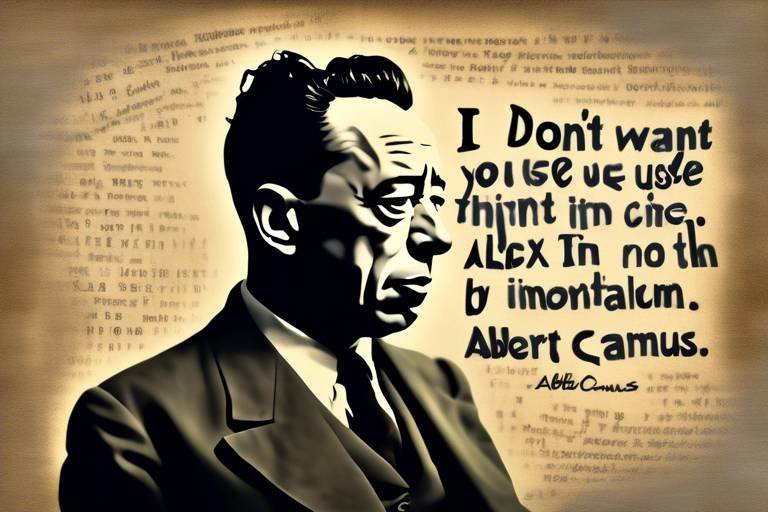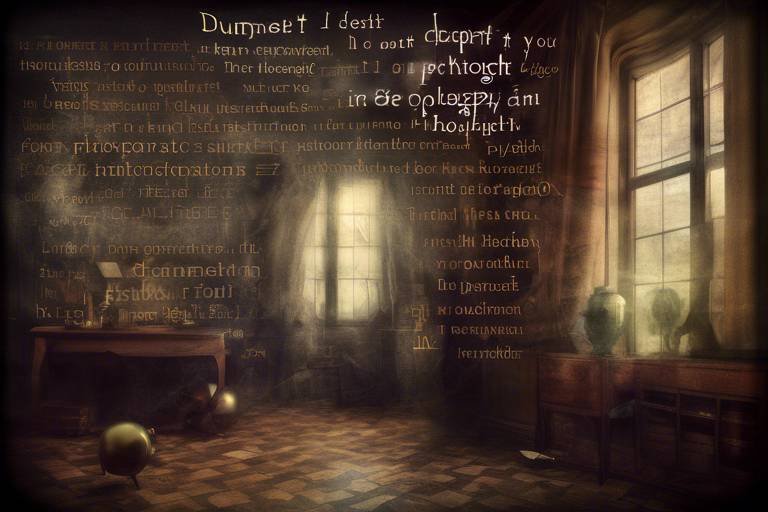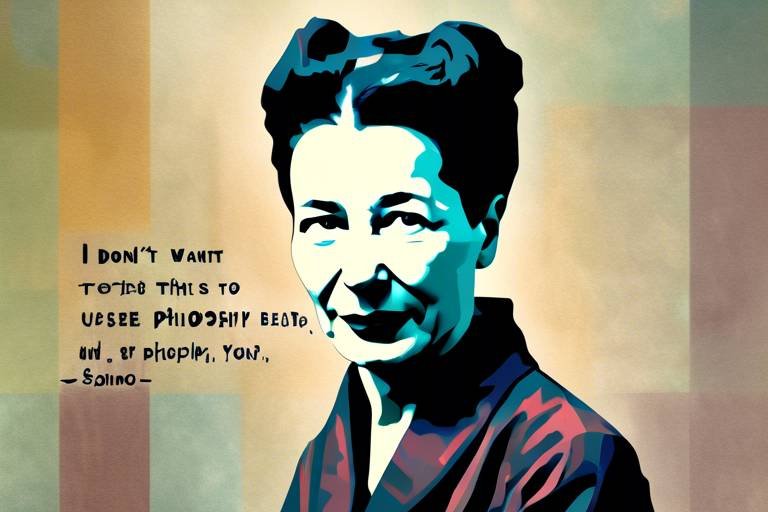Technology is not Neutral - Understanding Heidegger's Philosophy of Technology
In an age dominated by screens, apps, and gadgets, it's easy to think of technology as just a set of tools we use to make our lives easier. However, the German philosopher Martin Heidegger challenges us to rethink this notion. He suggests that technology is not merely a neutral instrument at our disposal; it profoundly shapes our understanding of existence itself. By diving into Heidegger's philosophy, we uncover the intricate relationship between technology and our being, revealing how our tools are not just extensions of ourselves but also frameworks that define our reality.
Heidegger argues that technology serves as a way of revealing, fundamentally altering how we perceive the world around us. This perspective invites us to consider questions like: How does our reliance on technology influence our thoughts, our interactions, and our very understanding of what it means to be human? In this exploration, we will navigate Heidegger's critiques of modern technology, the concept of technological determinism, and the implications for our authenticity and existence.
At the heart of Heidegger's philosophy is the idea that technology is not just about efficiency or functionality. Instead, it is a lens through which we view our existence. He posits that technology shapes our reality and influences our understanding of being. For instance, consider how the invention of the smartphone has transformed communication. No longer do we simply converse face-to-face; our interactions are mediated through screens, emojis, and social media platforms. This shift raises the question: Are we truly connecting, or are we merely exchanging information?
Heidegger's assertion challenges us to reflect on the essence of technology. It is not merely a collection of tools but a significant force that molds our perceptions and interactions. As we become increasingly immersed in technological environments, we must ask ourselves how these tools shape our thoughts, relationships, and ultimately, our existence.
Technological determinism is a concept that suggests technology shapes societal structures and individual behaviors. Heidegger warns us that technology often leads to unforeseen consequences, as our reliance on it can create a cycle of dependence that alters our values and priorities. For example, social media may connect us globally, but it can also foster isolation and anxiety. The more we engage with technology, the more it defines our reality, often in ways we do not anticipate.
Heidegger critiques the tendency of modern technology to dominate nature, leading to a disconnection between humanity and the world. This critique invites us to reconsider our relationship with technology and its implications for our existence. Are we using technology to enhance our lives, or are we becoming subservient to it?
In his critique of modern technology, Heidegger emphasizes its potential to dominate and enfranchise nature. He argues that this domination leads to a fragmented relationship between humanity and the natural world. As we harness technology to manipulate our environment, we risk losing sight of the intrinsic value of nature itself. This notion of 'Gestell', or enframing, highlights how technology constrains our perception and interaction with reality. It boxes us in, limiting our ability to experience the world in its fullness.
Heidegger's concept of enframing serves as a warning about the dangers of a technology-driven existence. When we view the world solely through the lens of technological efficiency, we may overlook the beauty and complexity of existence. This perspective can lead to a utilitarian mindset, where everything is valued only for its functionality. In this way, technology can become a barrier to authentic experiences and genuine connections.
Heidegger believes that technology alters human existence by shifting our focus from being to mere functionality and efficiency. We become preoccupied with optimizing our lives through technological means, often at the expense of deeper, more meaningful experiences. This shift raises critical questions: Are we living authentically, or are we merely existing within a framework defined by our devices? The answer to this question may determine the quality of our human experience in a technology-saturated world.
As we navigate the complexities of modern life, the relationship between technology and authenticity becomes increasingly significant. Heidegger suggests that technological advancements can hinder genuine human experiences and connections. In a world where interactions are often mediated by screens, how do we foster authentic relationships? Can we reclaim our humanity in a landscape dominated by technology?
To explore these questions, we must consider the role of mindfulness and intentionality in our technological engagement. By being conscious of how we use technology, we can strive to cultivate deeper connections and a more authentic existence. This journey requires us to reflect on our values and priorities, ensuring that technology serves as a tool for enhancing our lives rather than dictating them.
Heidegger introduces the concept of 'poiesis', emphasizing the creative aspect of technology. This notion invites us to view technology not just as a means of production but as a way to foster a deeper connection to nature and existence. When we engage with technology in a creative and intentional manner, we can uncover truths that are often obscured by technological dominance.
The interplay between art and technology offers a fascinating perspective on this relationship. Artistic practices can reveal truths about our existence that technology alone may obscure. For instance, consider how a painter uses technology to create a digital masterpiece. This fusion of art and technology can lead to new forms of expression that resonate with our experiences and emotions.
In conclusion, reclaiming a more authentic relationship with technology requires mindfulness and intentionality. By being aware of how technology influences our thoughts, interactions, and existence, we can take steps to engage with it more thoughtfully. This journey may involve setting boundaries, prioritizing face-to-face interactions, and embracing the beauty of the world around us. Ultimately, the goal is to harness technology as a tool that enhances our lives while remaining grounded in our humanity.
- What is Heidegger's view on technology? Heidegger believes that technology is not neutral; it shapes our understanding of existence and influences our relationship with the world.
- How does technology impact human existence? Technology shifts our focus from being to functionality, potentially hindering authentic experiences and connections.
- What is 'Gestell'? 'Gestell' refers to the concept of enframing, which highlights how technology constrains our perception and interaction with reality.
- How can we reclaim our relationship with technology? By practicing mindfulness and intentionality in our technological engagement, we can foster deeper connections and a more authentic existence.

The Essence of Technology
When we think about technology, it's easy to reduce it to just a collection of gadgets, apps, and machines that we use daily. However, Martin Heidegger challenges us to look deeper. He argues that technology is not merely a set of tools at our disposal; rather, it is a unique way of revealing the world around us. This revelation shapes our understanding of existence itself, influencing how we perceive reality and our place within it. Imagine technology as a lens through which we view the universe—sometimes it clarifies, and other times it distorts.
Heidegger's perspective invites us to consider the essence of technology as a mode of uncovering truths. For him, technology is not just about efficiency or productivity; it is about how it transforms our relationship with nature and ourselves. Through this lens, technology becomes a powerful force that can either connect us more deeply to existence or alienate us from it. In this sense, technology is a double-edged sword. It can illuminate paths to understanding or cast shadows that obscure our vision.
To grasp this concept fully, we can look at the difference between traditional craftsmanship and modern industrial production. In traditional craftsmanship, the artisan engages with materials and processes in a way that reflects a deep understanding of their essence. This is what Heidegger refers to as poiesis, a creative bringing-forth that connects us to the world. On the contrary, modern technology often reduces this relationship to mere functionality, focusing on output rather than the inherent qualities of the materials involved. This shift not only affects how we create but also how we experience the world.
| Traditional Craftsmanship | Modern Technology |
|---|---|
| Emphasizes connection with materials | Focuses on efficiency and productivity |
| Encourages creativity and personal expression | Standardizes processes and outputs |
| Fosters a sense of place and belonging | Often leads to disconnection from nature |
Moreover, Heidegger warns us that the essence of technology can lead to a dangerous mindset known as technological enframing. This concept refers to how technology can constrain our perception, limiting our understanding of what is possible. We begin to see the world primarily through the lens of technological efficiency, often overlooking the rich tapestry of existence that lies beyond our screens and devices. In this way, technology can become a filter that narrows our vision rather than expanding it.
In conclusion, understanding the essence of technology through Heidegger's philosophy encourages us to reflect on our relationship with it. Are we merely users of technology, or do we engage with it in a way that honors its potential to reveal deeper truths? This question challenges us to consider how we can utilize technology not just as a tool for convenience but as a means of enriching our understanding of the world and our place within it.

Technological Determinism
The concept of suggests that technology is not just a collection of tools we use; rather, it acts as a powerful force that shapes our society and influences our behaviors. Imagine technology as a river, flowing through the landscape of human existence, carving out paths and shaping the terrain in ways we often don’t realize. This idea posits that the development and implementation of technology can dictate the direction of social change, often leading us down unforeseen paths.
In essence, technological determinism argues that technology is the primary driver of societal evolution. It can lead to significant shifts in how we interact with each other and the world around us. For instance, consider the rise of social media. Platforms like Facebook and Twitter have transformed the way we communicate, creating a new digital landscape where information spreads like wildfire. The impact of these technologies extends beyond mere communication; they reshape our social structures, influence our opinions, and even alter our perceptions of reality.
However, it is essential to recognize that while technology can drive change, it does not operate in a vacuum. Human choices and cultural contexts play a crucial role in shaping how technologies are developed and utilized. This interplay creates a complex relationship where technology influences society, but societal needs and values also guide technological advancements.
To better understand this relationship, let’s break down some key aspects of technological determinism:
- Influence on Social Structures: Technology can reinforce or challenge existing power dynamics. For example, the internet has democratized access to information, but it has also facilitated the rise of misinformation and echo chambers.
- Behavioral Shifts: The convenience of smartphones has changed how we interact with the world, often prioritizing efficiency over deeper human connections.
- Unintended Consequences: Advancements in technology can lead to outcomes that were not anticipated, such as job displacement due to automation.
The implications of technological determinism are profound. As we become increasingly reliant on technology, we must ask ourselves: Are we shaping technology, or is technology shaping us? This question invites us to reflect on our role as active participants in a technological society. Are we merely passive consumers, or can we engage with technology in a way that aligns with our values and enhances our human experience?
In conclusion, while technology undoubtedly influences societal structures and individual behaviors, it is crucial to recognize that we have agency in how we engage with these technologies. By being aware of the dynamics at play, we can navigate the technological landscape with intention, ensuring that our relationship with technology remains balanced and authentic.

Heidegger's Critique of Modern Technology
Martin Heidegger's critique of modern technology is not just a simple condemnation; it is a profound inquiry into how technology shapes our existence and our relationship with the world around us. He argues that modern technology is characterized by its tendency to dominate and control nature, reducing it to a mere resource for human exploitation. This perspective invites us to consider the broader implications of our technological advancements. Are we merely using technology, or is technology using us? In this sense, Heidegger suggests that our increasing reliance on technology leads to a disconnection from the essence of being.
One of the key components of Heidegger's critique is his concept of Gestell, or enframing. This term encapsulates the idea that modern technology frames our understanding of reality in a specific way, constraining our perceptions and limiting our interactions with the world. When we view nature solely as a resource to be exploited, we risk losing sight of its intrinsic value. Heidegger warns that this enframing can lead to a mechanistic worldview, where everything is reduced to mere functionality and efficiency. Consequently, we become mere cogs in the technological machinery, losing our authentic selves in the process.
Moreover, Heidegger highlights the irony that while technology promises to enhance our lives, it often alienates us from our true nature. For instance, consider how social media, a product of modern technology, connects us with others but simultaneously fosters feelings of isolation and superficiality. This paradox illustrates how technological advancements can create a façade of connectivity while eroding genuine human relationships. In this light, we must ask ourselves: are we truly engaging with one another, or are we merely interacting with the screens that mediate our experiences?
Heidegger's critique extends beyond the individual to societal structures. He argues that the technological mindset infiltrates our institutions, shaping our values and priorities. For example, in a world driven by technological efficiency, decisions are often made based on data and algorithms rather than human empathy and understanding. This shift can lead to a cold, calculating approach to governance, education, and even healthcare, where the human element is overshadowed by the desire for optimization. As we navigate this landscape, it becomes crucial to reflect on the ethical implications of our technological choices.
In conclusion, Heidegger's critique of modern technology serves as a poignant reminder of the need for a more mindful engagement with the tools we create. Rather than allowing technology to dictate our lives, we must strive to reclaim our agency and foster a deeper connection with the world around us. By recognizing the limitations imposed by enframing, we can begin to navigate a path that honors both our humanity and the natural world. After all, technology should serve as an extension of our being, not a replacement for it.
- What is Heidegger's main argument regarding technology?
Heidegger argues that technology is not a neutral tool but a way of revealing the world that can dominate and control our perceptions and relationships. - What does 'Gestell' mean?
'Gestell' refers to the enframing nature of technology, which constrains our understanding of reality and reduces nature to a resource. - How does technology affect human relationships?
Heidegger suggests that technology can create a façade of connectivity while fostering feelings of isolation and superficiality in human interactions. - What is the ethical implication of technological advancements?
Technological advancements can lead to decisions based on efficiency rather than empathy, impacting societal values and priorities.

The Danger of Technological Enframing
When we think about technology, it’s easy to see it as just a collection of gadgets and tools that make our lives easier. However, Martin Heidegger invites us to dive deeper into this notion, suggesting that technology does more than simply serve us; it fundamentally shapes how we perceive and interact with the world. This concept, known as technological enframing or 'Gestell', is a critical term in Heidegger's philosophy. It refers to the way technology organizes and constrains our understanding of existence, often leading us to view the world merely as a resource to be exploited.
Imagine a world where every tree is seen only as lumber, every river as a source of energy, and every human interaction as a transaction. This is the danger of enframing—it reduces the richness of our reality to mere functionality. Instead of appreciating the beauty of nature, we become trapped in a mindset that prioritizes efficiency and utility above all else. This shift in perception not only alters our relationship with the environment but also diminishes our capacity for genuine human connections.
Heidegger warns that this enframing can lead to a dangerous detachment from the essence of being. When technology dictates our worldview, we risk losing touch with what it means to be truly alive, to experience the world in all its complexity and wonder. We become so focused on optimizing our lives through technological means that we forget to ask ourselves fundamental questions about our existence. Are we living authentically, or are we merely existing within a framework that technology has constructed for us?
To illustrate this point, consider the following table that summarizes the impacts of technological enframing:
| Aspect | Impact of Technological Enframing |
|---|---|
| Perception of Nature | Reduced to mere resources |
| Human Relationships | Transactional rather than relational |
| Understanding of Existence | Shifted from being to functionality |
| Authenticity | Compromised by technological efficiency |
As we navigate through a world increasingly dominated by technology, it becomes essential to recognize these dangers. We must actively resist the temptation to allow technology to dictate our lives. Instead, we should strive for a more mindful engagement with technology, one that recognizes its potential to enrich our experiences without allowing it to define our existence. By doing so, we can reclaim our relationship with the world around us, fostering a deeper connection to both nature and one another.
In conclusion, the danger of technological enframing lies not just in what we lose but also in what we fail to recognize. As we embrace technology, let’s also embrace the responsibility to question its influence on our lives and our understanding of being. After all, in a world increasingly shaped by technology, it is our humanity that must remain at the forefront.
- What is technological enframing?
Technological enframing, or 'Gestell', refers to the way technology organizes and constrains our perception of reality, often reducing it to mere functionality.
- How does enframing affect human relationships?
Enframing can lead to relationships that are more transactional than genuine, as technology prioritizes efficiency over authentic connection.
- What can we do to combat the dangers of enframing?
We can combat enframing by engaging with technology mindfully, ensuring that we maintain a focus on authenticity and meaningful experiences.

Impact on Human Existence
Heidegger's philosophy reveals a profound concern about the impact of technology on human existence. He argues that as we become increasingly reliant on technological advancements, we risk losing touch with our authentic selves. Instead of engaging with the world around us, we often find ourselves trapped in a cycle of mere functionality and efficiency. This shift in focus can lead to a disconnection from our inherent nature and the essence of being. Imagine living in a world where every interaction is mediated by a screen, where our relationships are filtered through social media, and where the beauty of the natural world is overshadowed by the glow of our devices. It’s a bit like trying to appreciate a painting while standing behind a glass wall; the beauty is there, but the connection is lost.
As technology continues to evolve, we find ourselves adopting a mindset that prioritizes speed and convenience over depth and understanding. This can lead to a phenomenon that Heidegger describes as 'the forgetfulness of being.' We become so engrossed in the efficiency of technological processes that we neglect the more profound questions about our existence and purpose. For instance, consider how many of us have experienced a moment where we are so engaged with our phones that we miss the beauty of a sunset or the laughter of a friend. In these moments, we are not just distracted; we are distancing ourselves from the richness of our human experience.
Moreover, Heidegger warns of the consequences of this disconnection. When we prioritize technology over our authentic selves, we risk becoming mere cogs in a vast machine. Our identities become intertwined with our devices, leading to a sense of alienation and a loss of individuality. In a world driven by algorithms and data, how do we reclaim our humanity? How do we ensure that we are not just existing but truly living? The answers lie in mindfulness and intentionality. By actively choosing how we engage with technology, we can foster a deeper connection to our own existence and the world around us.
To illustrate this point, consider the following table that outlines the contrasting impacts of technology on human existence:
| Aspect | Positive Impact | Negative Impact |
|---|---|---|
| Communication | Instant connectivity with others | Superficial interactions and loneliness |
| Information Access | Vast resources at our fingertips | Overload of information and distraction |
| Creativity | New tools for artistic expression | Potential loss of traditional skills and authenticity |
| Work | Increased productivity and efficiency | Burnout and loss of work-life balance |
As we navigate through this complex relationship with technology, it's essential to reflect on our choices and their implications for our existence. Are we living authentically, or are we merely existing within the confines of technological frameworks? By embracing a more mindful approach, we can cultivate a deeper understanding of ourselves and our place in the world, ensuring that technology serves as a tool for enhancing our lives rather than diminishing them.
- What is Heidegger's main argument about technology? Heidegger argues that technology shapes our understanding of being and existence, often leading to a disconnection from our authentic selves.
- How does technology impact human relationships? Technology can facilitate communication but may also lead to superficial interactions and a sense of loneliness.
- What can we do to reclaim our authenticity in a technological world? Practicing mindfulness and intentional engagement with technology can help foster a deeper connection to our existence.
- What does Heidegger mean by 'the forgetfulness of being'? It refers to the tendency to overlook fundamental questions about our existence in favor of technological efficiency.

Technology and Authenticity
In today's fast-paced world, where technology permeates every aspect of our lives, the question of authenticity has become increasingly pressing. What does it mean to be authentic in an age dominated by screens, algorithms, and digital interactions? Martin Heidegger's philosophy provides a profound lens through which we can examine this issue. He suggests that technology, while offering immense convenience and connectivity, often leads us away from genuine experiences and authentic relationships.
Heidegger posits that the essence of technology is not merely in its utility but in how it shapes our perception of reality. When we engage with technology, we risk losing touch with our true selves and the world around us. Consider how social media platforms, while connecting us with friends and family, can also create a facade of authenticity. We curate our lives, presenting polished versions of ourselves, which can lead to a disconnection from our genuine emotions and experiences. This curated existence raises the question: are we truly being ourselves, or are we simply performing for an audience?
Moreover, technology often promotes a culture of immediacy and efficiency, pushing us to prioritize speed over depth. In this context, authentic experiences become rare gems, overshadowed by the constant barrage of notifications and distractions. Heidegger warns that in our relentless pursuit of efficiency, we may sacrifice the richness of our human experience. The depth of a conversation, the beauty of a sunset, or the joy of creating art can all be diminished when viewed through the lens of productivity.
To navigate this technological landscape while preserving authenticity, we must consciously engage with technology. This means being mindful of how we use it and recognizing its impact on our lives.
- Set boundaries around technology use to foster genuine interactions.
- Prioritize face-to-face communication over digital conversations.
- Engage in activities that encourage creativity and self-expression.
Ultimately, the challenge lies in finding a balance. Technology can be a double-edged sword; it has the potential to enrich our lives while simultaneously threatening our authenticity. By critically examining our relationship with technology, we can foster a more authentic existence, one that honors our true selves in a world that often pushes us toward superficiality.
- How does technology impact our relationships? Technology can both connect and isolate us. While it allows for instant communication, it can also create superficial interactions that lack depth.
- What steps can I take to maintain authenticity in a digital world? You can set boundaries for technology use, prioritize in-person interactions, and engage in creative activities that foster genuine self-expression.
- Is it possible to use technology mindfully? Yes, by being intentional about how and when you use technology, you can create a balanced relationship that enhances your life without compromising authenticity.

Heidegger's Notion of 'Poiesis'
When we dive into Martin Heidegger's philosophy, one of the most intriguing concepts that emerges is 'poiesis.' This term, derived from the Greek word for "to make" or "to create," encapsulates the essence of bringing forth into being. Heidegger suggests that technology, often viewed as a cold, mechanical force, actually possesses a deeper, more creative aspect. It’s like looking at a beautiful painting and realizing that the brush strokes are not just random; they tell a story and reveal a connection to the artist's soul.
In Heidegger's view, poiesis is not merely about the act of creation in the traditional sense, such as crafting a sculpture or composing a symphony. It extends to how we engage with the world around us. When we engage in poiesis, we are participating in a process that reveals truths about our existence and our relationship with nature. This perspective shifts the narrative from technology as a mere tool to technology as a medium through which we can express our understanding of the world. Imagine a gardener who doesn’t just plant seeds but cultivates a relationship with the earth, nurturing life and fostering growth. This is the essence of poiesis.
Heidegger contrasts poiesis with what he terms 'techné,' which refers to the skills and techniques involved in creation. While techné can often be mechanistic and impersonal, poiesis is inherently human and relational. It invites us to reflect on our place in the universe and encourages a more profound connection with our surroundings. For instance, when we engage in artistic endeavors, we are not just producing objects; we are expressing our being and revealing aspects of existence that might otherwise remain hidden. This process can be transformative, allowing us to see the world from new perspectives.
Furthermore, Heidegger emphasizes that in our modern age, technology tends to obscure this creative aspect of poiesis. Instead of fostering a relationship with nature, it often leads to a disconnection, reducing our interactions to mere functionality. For example, consider the way we consume media today; it can be so overwhelming that we forget to pause and appreciate the artistry behind it. We scroll through endless feeds, losing sight of the stories and emotions that each piece conveys. This is where the danger lies – in losing our sense of wonder and the ability to connect authentically with our experiences.
To reclaim this sense of poiesis, we must become more intentional in our technological engagements. This means asking ourselves questions like:
- How does this technology enhance my life?
- Am I using it to connect with others or to escape reality?
- What stories are being told through the technology I engage with?
By reflecting on these questions, we can start to recognize technology not just as a means to an end but as a way to reveal deeper truths about ourselves and our world. In essence, poiesis encourages us to see technology as a partner in our journey of existence rather than a mere tool for productivity. It invites us to embrace creativity, fostering a relationship with the world that is both authentic and enriching.

Art and Technology
When we think about art and technology, it’s easy to imagine them as two opposing forces, like oil and water. However, Martin Heidegger challenges us to see them not as adversaries but as partners in the dance of existence. Art, in its purest form, serves as a bridge between humanity and the world, while technology often seems to create barriers. But what if we could leverage technology to enhance our artistic expressions rather than diminish them? This is where Heidegger's philosophy becomes particularly enlightening.
Heidegger argues that technology can be a means of revealing deeper truths about our existence. Think of technology as a lens through which we can view the world more clearly. For instance, consider how digital art forms have transformed traditional art practices. Artists now have tools at their disposal that allow them to create immersive experiences that engage audiences in ways previously unimaginable. This fusion of art and technology not only expands the creative possibilities but also invites viewers to reflect on their relationship with both.
However, it’s crucial to remain vigilant. While technology can amplify artistic expression, it can also obscure genuine experiences. The question we must ask ourselves is: Are we using technology to enhance our creativity, or has it become a crutch that stifles our authentic expression? To navigate this delicate balance, we need to cultivate a mindful approach to our technological engagement. Here are some ways we can do this:
- Embrace Experimentation: Artists should feel free to explore new technologies without fear of failure. Each experiment is a step towards discovering new forms of expression.
- Prioritize Authenticity: Always aim for genuine expression rather than simply following trends dictated by technology.
- Engage with Nature: Use technology to reconnect with the natural world. For example, digital installations can incorporate elements of nature, reminding us of our roots.
Moreover, the interplay between art and technology can lead to a richer understanding of our existence. Take, for instance, the rise of virtual reality (VR) art. This innovative medium allows artists to create fully immersive environments that can evoke emotions and thoughts in ways traditional art forms might not. Imagine stepping into a painting and experiencing it from within; this is the kind of transformative experience technology can provide. Yet, we must tread carefully, ensuring that we don’t lose sight of the human experience in the process.
Ultimately, the relationship between art and technology is a complex tapestry woven from threads of creativity, intention, and reflection. By understanding and embracing this relationship, we can create a future where technology serves as a tool for deeper artistic expression rather than a barrier to it. In this way, we honor Heidegger's vision of technology as a revealing force, one that can illuminate the profound connections between art, humanity, and the world around us.
- How does Heidegger view the role of technology in art?
Heidegger sees technology as a potential means to reveal deeper truths about existence, emphasizing the importance of intentional engagement with technological tools. - Can technology enhance artistic expression?
Yes, technology can provide artists with innovative tools that expand their creative possibilities, allowing for new forms of expression and engagement with audiences. - What is the danger of technology in art?
While technology can enhance creativity, it can also obscure genuine experiences, leading to a disconnect between the artist and their work.

Reclaiming Our Relationship with Technology
In a world where technology is often seen as an extension of ourselves, reclaiming our relationship with it can feel like a daunting task. However, it is essential to recognize that technology should serve us, not the other way around. The first step in this journey is to cultivate mindfulness in our interactions with technology. This means being aware of how and why we use various devices and applications. Are we scrolling mindlessly through social media, or are we using these platforms to connect meaningfully with others? By asking ourselves these questions, we can start to take back control.
Moreover, we must embrace intentionality in our technological engagements. This involves setting clear boundaries around our usage. For instance, designating specific times for checking emails or social media can help us avoid the constant distractions that technology often brings. Think of it as creating a digital detox routine, where we intentionally unplug to reconnect with the world around us. Imagine spending an afternoon without your smartphone—what might you discover about your surroundings and yourself?
Another vital aspect of reclaiming our relationship with technology is focusing on quality over quantity. Instead of bombarding ourselves with a plethora of apps and gadgets, we should prioritize tools that genuinely enhance our lives. For example, consider using a single note-taking app that works seamlessly across devices rather than juggling multiple platforms that only complicate things. This simplification can lead to a more fulfilling and less stressful technological experience.
Additionally, fostering community and connection through technology can help us reclaim its positive aspects. Engaging in online forums, virtual meetups, or collaborative projects can remind us that technology can indeed facilitate genuine human connections. It's all about shifting our perspective from viewing technology as a barrier to seeing it as a bridge. When we share our experiences and insights with others, we not only enrich our own lives but also contribute to a collective understanding of how to navigate this complex digital landscape.
To further illustrate this, let's consider a table that outlines some practical strategies for reclaiming our relationship with technology:
| Strategy | Description |
|---|---|
| Mindfulness | Be aware of your technology usage and its impact on your life. |
| Intentionality | Set clear boundaries and designate specific times for technology use. |
| Quality Over Quantity | Focus on using fewer tools that genuinely enhance your life. |
| Community Engagement | Participate in online communities to foster genuine connections. |
Lastly, as we navigate this journey, it's crucial to engage in ongoing reflection. Regularly assess how technology fits into your life and whether it aligns with your values and goals. This self-awareness can act as a compass, guiding you toward a more authentic relationship with technology. Remember, technology is not inherently good or bad; it is our relationship with it that shapes its impact on our lives.
By taking these steps, we can transform our relationship with technology from one of dependency to one of empowerment. Let’s not forget that while technology can enhance our lives, it should never define them. Instead of letting it dictate our existence, we can choose to harness its potential to enrich our experiences and deepen our connections with the world around us.
- How can I start being more mindful with technology? Begin by tracking your usage for a week to identify patterns and areas for improvement.
- What are some good practices for setting boundaries with technology? Designate tech-free times, such as during meals or before bedtime, to help you disconnect.
- Can technology ever be truly beneficial? Absolutely! When used intentionally, technology can enhance communication, creativity, and learning.
- What does it mean to focus on quality over quantity in technology? It means choosing fewer, more effective tools that genuinely serve your needs rather than using many that complicate your life.
Frequently Asked Questions
- What is Heidegger's perspective on technology?
Heidegger views technology as more than just a collection of tools; he sees it as a way of revealing the world around us. It shapes our understanding of being and existence, urging us to reflect on how it influences our lives and relationships.
- What does technological determinism mean?
Technological determinism is the idea that technology shapes societal structures and individual behaviors. Heidegger highlights that this influence can lead to unexpected consequences, often altering the fabric of our daily lives in profound ways.
- How does Heidegger critique modern technology?
Heidegger critiques modern technology for its tendency to dominate nature, creating a disconnect between humanity and the world. He argues that this relationship can lead to a loss of authenticity in our experiences and interactions.
- What is 'Gestell' or enframing?
'Gestell' is a term Heidegger uses to describe how technology constrains our perception of reality. It frames our understanding in a way that limits our ability to engage with the world authentically, reducing our experiences to mere functionality.
- How does technology impact human existence?
Heidegger believes that technology shifts our focus from being to mere functionality and efficiency. This shift can lead to a superficial existence, where genuine human experiences and connections are often overlooked.
- Can technology hinder authenticity?
Yes, according to Heidegger, technological advancements can obstruct genuine human experiences and connections. As we become more reliant on technology, we may find ourselves disconnected from our true selves and from one another.
- What is 'poiesis' in Heidegger's philosophy?
'Poiesis' refers to the creative aspect of technology. Heidegger emphasizes that technology can foster a deeper connection to nature and existence, allowing for a more authentic engagement with the world.
- How does art relate to technology?
Heidegger explores the interplay between art and technology, suggesting that artistic practices can reveal truths that are often obscured by technological dominance. Art serves as a means to reconnect with deeper aspects of existence.
- How can we reclaim our relationship with technology?
Reclaiming a more authentic relationship with technology involves mindfulness and intentionality in our technological engagements. By being aware of how we use technology, we can foster deeper connections and experiences.



















